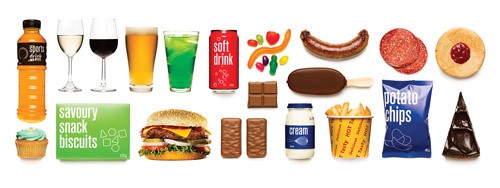Introduction
The Australian Dietary Guidelines recommend the number of standard serves we should consume from the five food groups each day, for a nutritious and balanced diet.
The recommended intake amounts differ by age, gender and life stage.
Click here to see the recommended intakes.
The size of a standard serve can be different within food groups and some sizes have changed since the 2003 guidelines. Continue reading to find out how much is a standard serve of your favourite foods.
Remember
- The Australian Dietary Guidelines recommend the number of standard serves we should consume from the five food groups each day.
- Recommended intake amounts differ by age, gender and life stage.
Standard serves of each food group
The following images have been sourced from http://www.eatforhealth.gov.au/food-essentials/how-much-do-we-need-each-day/serve-sizes
What is a serve of vegetables?

A standard serve is about 75g (100–350kJ) or:
- ½ cup cooked green or orange vegetables (for example, broccoli, spinach, carrots or pumpkin)
- ½ cup cooked dried or canned beans, peas or lentils (preferably with no added salt)
- 1 cup green leafy or raw salad vegetables
- ½ cup sweet corn
- ½ medium potato or other starchy vegetables (sweet potato, taro or cassava)
- 1 medium tomato
What is a serve of fruit?

A standard serve is about 150g (350kJ) or:
- 1 medium apple, banana, orange or pear
- 2 small apricots, kiwi fruits or plums
- 1 cup diced or canned fruit (no added sugar)
Or only occasionally:
- 125ml (½ cup) fruit juice (no added sugar)
- 30g dried fruit (for example, 4 dried apricot halves, 1½ tablespoons of sultanas)
What is a serve of grain* (cereal) food?

A standard serve is (500kJ) or:
- 1 slice (40g) bread
- ½ medium (40g) roll or flat bread
- ½ cup (75-120g) cooked rice, pasta, noodles, barley, buckwheat, semolina, polenta, bulgur or quinoa
- ½ cup (120g) cooked porridge
- 2/3 cup (30g) wheat cereal flakes
- ¼ cup (30g) muesli
- 3 (35g) crispbreads
- 1 (60g) crumpet
- 1 small (35g) English muffin or scone
*Grain (cereal) foods, mostly wholegrain and/or high cereal fibre varieties
How much is a serve of lean meat and poultry, fish, eggs, nuts and seeds, and legumes/beans?

A standard serve is (500–600kJ):
- 65g cooked lean red meats such as beef, lamb, veal, pork, goat or kangaroo (about 90-100g raw)
- 80g cooked lean poultry such as chicken or turkey (100g raw)
- 100g cooked fish fillet (about 115g raw) or one small can of fish
- 2 large (120g) eggs
- 1 cup (150g) cooked or canned legumes/beans such as lentils, chick peas or split peas (preferably with no added salt)
- 170g tofu
- 30g nuts, seeds, peanut or almond butter or tahini or other nut or seed paste (no added salt)*
*Only to be used occasionally as a substitute for other foods in the group (note: this amount for nuts and seeds gives approximately the same amount of energy as the other foods in this group but will provide less protein, iron or zinc).
How much is a serve of milk*, yoghurt*, cheese* and/or alternatives?

A standard serve is (500–600kJ):
- 1 cup (250ml) fresh, UHT long life, reconstituted powdered milk or buttermilk
- ½ cup (120ml) evaporated milk
- 2 slices (40g) or 4 x 3 x 2cm cube (40g) of hard cheese, such as cheddar
- ½ cup (120g) ricotta cheese
- ¾ cup (200g) yoghurt
- 1 cup (250ml) soy, rice or other cereal drink with at least 100mg of added calcium per 100ml
*Choose mostly reduced fat
If you do not eat any foods from this group, try the following foods, which contain about the same amount of calcium as a serve of milk, yoghurt, cheese or alternatives (note: the kilojoule content of some of these serves (especially nuts) is higher so watch this if trying to lose weight).
- 100g almonds with skin
- 60g sardines, canned in water
- ½ cup (100g) canned pink salmon with bones
- 100g firm tofu (check the label as calcium levels vary)
Discretionary choices

One serve of ‘discretionary’ food or drinks is 600kJ, which is the equivalent of 2 scoops of ice cream, 1/3 of a meat pie or only a few squares of chocolate.
The Australian Dietary Guidelines recommend limiting our intake of discretionary choices, as they are not an essential part of a nutritious diet. Nutrition Australia advises limiting your intake of discretionary choices to a maximum of one serve per day (approx. 600kJ).
The difference between standard serves, serve sizes and portions
A standard serve might be different to the amount of food you choose to eat at any given time – this is called a portion. For example, one standard serve of bread is 1 slice, but you might have 2 slices in a sandwich, so your portion of bread for that meal is 2 standard serves.
A standard serve is also not the same as the serving size listed on a packet of food. Those serving sizes are chosen by the food manufacturer and are often not based on any official guidelines or recommendations. For example, the Australian Dietary Guidelines describe a standard serve of breakfast cereal as 30g, but the serving size listed on a cereal packet could be 45g, which is 1.5 standard serves.
The key to a balanced diet is to enjoy a variety of foods from the five core food groups every day and to limit your intake of foods and drinks that are high in saturated fat, sugar and salt.
For more information about healthy eating, see our Australian Dietary Guidelines factsheet.
